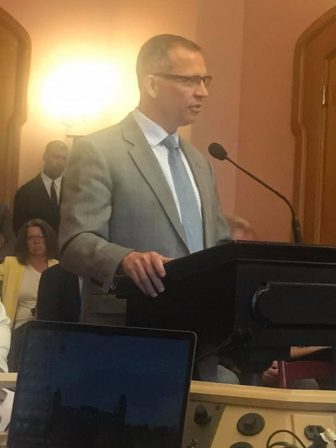
Tuesday, June 4, 2019
House Primary and Secondary Education Committee — Chair Blessing, Vice Chair Jones, Ranking Member Robinson and members of the Committee:
My name is Scott DiMauro. I am a high school social studies teacher from Worthington with 16 years of classroom experience, and I currently serve as Vice President of the Ohio Education Association (OEA).
On behalf of the 122,000 members of OEA, thank you for the opportunity to testify in support of House Bill 239, the Testing Reduction Act.
I would like to begin by thanking the joint sponsors, Representatives Gayle Manning and Erica Crawley, as well as the bi-partisan cosponsors of HB 239.
Over-testing is a real issue and it is keenly felt by Ohio’s parents, teachers and students. Students are experiencing testing anxiety and losing educational opportunities because of time spent on testing. I’m sure you’ve heard stories like these, and will no doubt hear more as you consider this bill.
Reducing testing is a worthy goal. To be clear, there will still be state-required and district-required testing if HB 239 is enacted. However, we are seeking greater balance which this bill helps to achieve. OEA enthusiastically supports the provisions of HB 239. I’ll review each of them briefly.
“Simply put, less time devoted to standardized testing means more time for teaching and learning in the classroom.”
Reducing State-Required Testing to Federal Minimums
 Federal law, the Every Student Succeeds Act (ESSA), requires a total of 17 tests for accountability purposes. These include annual testing in both English Language Arts (ELA) and Math in grades 3-8 as well as once in high school. Further, the law requires testing in science once in elementary school, middle school and high school.
Federal law, the Every Student Succeeds Act (ESSA), requires a total of 17 tests for accountability purposes. These include annual testing in both English Language Arts (ELA) and Math in grades 3-8 as well as once in high school. Further, the law requires testing in science once in elementary school, middle school and high school.
Ohio has 21 state-required achievement or end-of-course tests.
In grades 3-8 the state-required tests align with federal minimums. However, Ohio has a total of seven end-of-course exams in high school; exceeding the federal minimums by four tests. HB 239 would eliminate end-of-course exams in Geography, ELA I, American History and American Government.
Eliminating a state-required test on these subjects does not mean that they will not be taught.
Our state standards and courses that students need to take and pass in order to graduate remain unchanged. OEA does not believe that we need a state-required test for a subject to be important. In seeking to reduce testing, the most immediate step lawmakers can take is to reduce state-required testing to the 17 tests required under federal law.
Work Groups on District-Required Testing
The amount of testing that students endure is not limited to the state-required tests. Testing required by the school district also plays a major role. The bill requires each school district to form a work group to examine the amount of time students spend on district-required testing and make recommendations to the district board of education about how to reduce the testing load on students.
This work group would consist of parents, teachers and school administrators. In making their recommendations, the work group would consider: the time students spend on district-required testing, the district testing calendar, whether groups of students are tested at a greater rate than others, the purpose and use of tests and testing data, the financial cost to the district, and whether any tests are duplicative. The work group would also consider any previous testing audit or examination of testing that the district may have already performed.
“OEA believes there is great value in having this discussion at the district level.”
It can lead to recommendations that reduce testing time, save money and return instructional time to the classroom. It can also lead to a greater understanding among stakeholders as to the purpose and value of testing that is currently in place. OEA feels it is vitally important that teachers and parents are a central part of this conversation and strongly supports this provision of the bill.
Annual Board Resolution for Districts that Exceed Testing Caps
 Current law establishes a cap on testing time.
Current law establishes a cap on testing time.
Senate Bill 3, passed in the 131st General Assembly, states that school districts should ensure that no student is required to spend a cumulative amount of time in excess of 2% of the school year taking state-required or district-required assessments or 1% of the school year taking practice or diagnostic tests to prepare for testing. However, the local board of education may exceed those limits by passing a resolution after holding a public meeting.
At present it is unclear how many school boards have passed such a resolution. The Ohio Department of Education (ODE) does not track this information. Districts that are exceeding the testing caps may have passed a resolution as a one-time action or possibly not taken the action at all.
HB 239 would require an annual passage of such a resolution if the district is exceeding testing caps and would require the local school board to consider recommendations of the local work group consisting of parents, teachers and administrators. Such resolutions would be reported to the Department and ODE would issue an annual report on student testing time. This report will help to quantify how much time students are spending on testing and will help inform policymakers at the state and local level.
Voluntary Participation in the ACT/SAT

Current law prescribes that the ACT or SAT be administered to all 11th grade students each spring.
It is a great benefit to students that the state offers a paid administration of a college entrance exam.
However, if a student’s post-secondary plans do not include college (for instance a student enrolled in a career-technical program) then taking the ACT or SAT goes from a benefit to just another test they’re required to take.
HB 239 would require that the ACT/SAT is offered to 11th graders but that participation of students would be voluntary. OEA supports this change and believes that participation should be subject to a parental opt-out.
Closing Remarks
Chair Blessing, once again thank you for the opportunity to testify. There is a great deal of support and enthusiasm for reducing testing among OEA’s membership that is shared by students and parents around Ohio. OEA urges favorable consideration of HB 239.
I would be happy to answer questions at this time.
Current law prescribes that the ACT or SAT be administered to all 11th grade students each spring.
It is a great benefit to students that the state offers a paid administration of a college entrance exam.
However, if a student’s post-secondary plans do not include college (for instance a student enrolled in a career-technical program) then taking the ACT or SAT goes from a benefit to just another test they’re required to take.
HB 239 would require that the ACT/SAT is offered to 11th graders but that participation of students would be voluntary. OEA supports this change and believes that participation should be subject to a parental opt-out.
Closing Remarks
Chair Blessing, once again thank you for the opportunity to testify. There is a great deal of support and enthusiasm for reducing testing among OEA’s membership that is shared by students and parents around Ohio. OEA urges favorable consideration of HB 239.
I would be happy to answer questions at this time.
![]()
Additional Testimony Provided by the Following OEA Members
- Noel Blevins – Newark Teachers Association*
- Dan Heintz — Chardon Education Association
- Courtney Johnson — Columbus Education Association
- Kallee Bernish-Good — Student, Ft. Hayes Metropolitan High School, Columbus
- Colleen O’Connell — Reynoldsburg Education Association
- Rob Schofield — Avon Lake Education Association
- Erin Stevens — Pickerington Education Association*
- Gretchen Tash — Princeton Association of Classroom Educators
- Mandy Wagner — Canton Professional Educators’ Association
* Written Testimony Only
